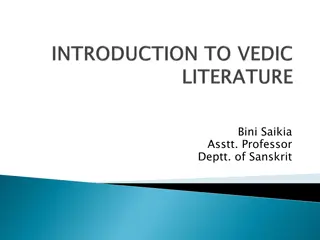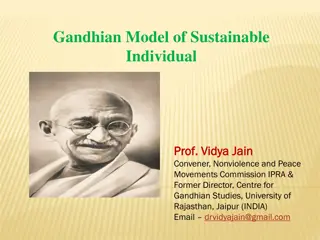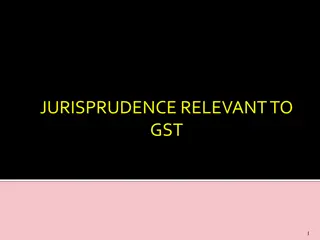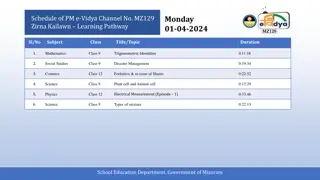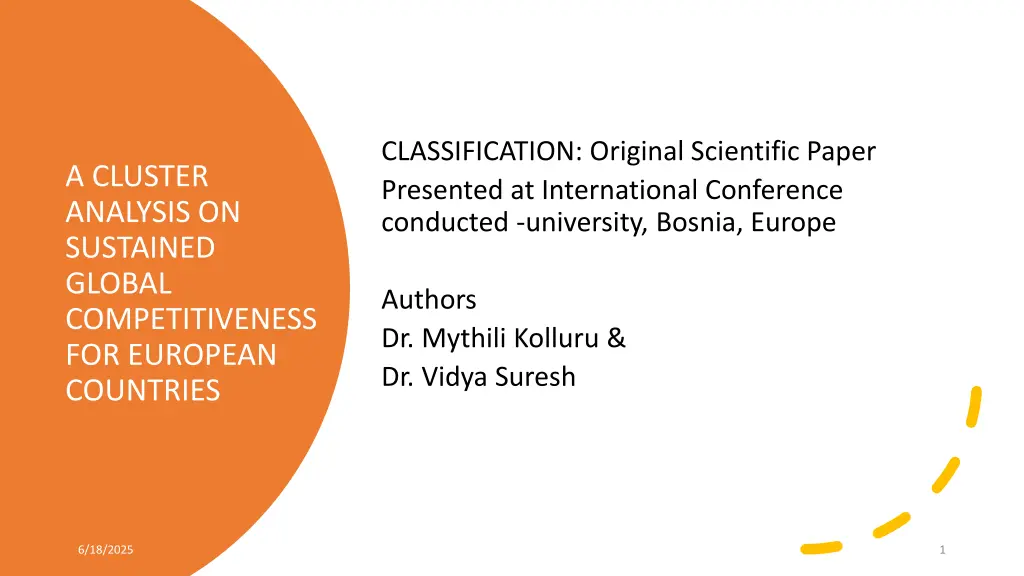
Analyzing European Competitiveness Through Cluster Analysis
This original scientific paper, presented at an international conference in Europe, discusses a cluster analysis on sustained global competitiveness for European countries. The study groups European nations based on the Global Competitiveness Index (GCI) using hierarchical and K-means clustering methods. Key drivers of competitiveness and the importance of institutions, macroeconomic environment, infrastructure, education, and innovation are highlighted. The paper aims to provide insights into the competitiveness of European countries from 2008 to 2017.
Download Presentation

Please find below an Image/Link to download the presentation.
The content on the website is provided AS IS for your information and personal use only. It may not be sold, licensed, or shared on other websites without obtaining consent from the author. If you encounter any issues during the download, it is possible that the publisher has removed the file from their server.
You are allowed to download the files provided on this website for personal or commercial use, subject to the condition that they are used lawfully. All files are the property of their respective owners.
The content on the website is provided AS IS for your information and personal use only. It may not be sold, licensed, or shared on other websites without obtaining consent from the author.
E N D
Presentation Transcript
CLASSIFICATION: Original Scientific Paper Presented at International Conference conducted -university, Bosnia, Europe A CLUSTER ANALYSIS ON SUSTAINED GLOBAL COMPETITIVENESS FOR EUROPEAN COUNTRIES Authors Dr. Mythili Kolluru & Dr. Vidya Suresh 6/18/2025 1
Executive Summary of the paper The Global Competitiveness Index (GCI) developed by Xavier Salai-Mart n, in collaboration with the World Economic Forum since 2005. Two main factors that govern the economy of the world are globalization and technology. This paper focuses on grouping the European nations according to GCI. It uses the hierarchical and K-means cluster to group countries from 2008 to 2017. The mean score of Europe during the study period was 4.7 and 40% of the European countries were found to be above the average and have been consistently performing well ahead of the average on competitiveness. 6/18/2025 2
12 drivers of competitiveness institutions macroeconomic environment Infrastructure higher education and training health and primary education goods market efficiency financial market development labor market efficiency technological readiness market size business sophistication innovation 6/18/2025 3
INTRODUCTION The World Economic Forum defines the competitiveness of a nation "as a set of institutions, policies, and factors that determine the level of productivity of a country." This GCI was developed by Prof. Xavier Sala I Martin in 2010. GCI segregates the 12 pillars into three groups. The GCI report includes two types of data; statistical (from IMF, UN) and surveys made to capture the respondents opinions from various countries. The Global Competitiveness Index introduces a new progress score ranging from 0 to 100, unlike the previous years prior to 2018. From 2018 the frontier of (100) corresponds to the global post of each indicator and typically represents a policy target. In order to keep our data consistent, we had to choose our study period from 2008 to 2017. 6/18/2025 4
LITERATURE REVIEW Artto (1987) defines competitiveness as a degree to which a nation can under free- market condition, produce goods and services that meet the test of international markets while simultaneously expanding the real income of its citizens. Aghion (2006) states that a competitive country is one that can ensure a high level of social welfare to its citizens. According to the work Aiginger (2006), a high level of GDP means a high level of living standards in the country. He believes that a high level of living standards is essential for the competitiveness of the country. The GCR 2007, defines competitiveness as the ability of a nation to provide citizens with high rising standards of living and high rates of employment on a sustainable basis. 6/18/2025 5
Global Competitiveness data for a ten-year period from 2008 to 2017 has been taken from World Economic Forum as the data set. A total of 35 European countries have been taken into consideration. European Union consisting of 27 countries is included in these 35 countries. Ukraine and the Russian federation have not been included as the Global Competitiveness Report categories them in Euroasia region. The research includes a descriptive statistics table and a trend chart for a quick reference of individual country performance. ANALYSIS METHOD 6/18/2025 6
The countries are classified based on a technique called cluster analysis. This paper applies the hierarchical cluster method or agglomeration method. In the method of agglomeration, a cluster once formed cannot be separated subsequently, but can only be connected to other clusters (Stahl and Sallis, 2012). We also apply K-means cluster as it generally gives more stable clusters. It is an interactive procedure. ANALYSIS METHOD 6/18/2025 7
TABLE 4.2 - COUNTRY CLASSIFICATION BASED ON GCI FROM 2008- 2017 Average Score GCI Cluster Number of Countries Country Members Cluster Label Switzerland, Netherlands, Germany, Sweden, UK, Finland 1 6 Sophisticated Economies Innovator Driven 5.50 Norway, Belgium, France, Ireland Denmark, Austria, Luxemburg, 2 7 5.18 Innovator Driven Economies Iceland, Estonia, Czech, Malta, Lithuania, Portugal, Italy, Slovenia, Bulgaria, Latvia, Slovak, Hungary, Montenegro, Spain, Poland, Macedonia 3 18 Romania, Croatia, Transition Innovation from Efficiency to 4.39 4 4 Albania, Serbia, Greece, Bosnia 3.89 Efficiency Driven 6/18/2025 8
ANALYSIS & RESULTS 6/18/2025 9
A COUNTRY WISE MEAN SCORE OF GLOBAL COMPETITIVENESS FOR EUROPE COVERING PERIOD 2008- 2017 6.0 5.0 4.0 3.0 2.0 1.0 0.0 Germany Estonia Czech Serbia Portugal Switzerland Luxembourg France Iceland Latvia Finland Austria Slovak Albania Poland Denmark Malta Bosnia Hungary Macedonia Netherlands Croatia Spain Sweden Ireland Greece Norway Italy Slovenia Romania Montenegro Belgium Lithuania Bulgaria United Kingdom Score Mean Score Country Mean Score Europe 6/18/2025 10
MEAN SCORE OF EUROPEAN COUNTRIES ON GLOBAL COMPETITIVENESS FROM 2008- 2017 5.00 4.90 4.80 Score 4.79 4.75 4.70 4.71 4.68 4.66 4.65 4.65 4.65 4.60 4.62 4.62 4.50 2008 2009 2010 2011 2012 2013 2014 2015 2016 2017 6/18/2025 11
DENDOGRAM USING AVERAGE LINKAGE (BETWEEN GROUPS) 6/18/2025 12
ELBOW RULE AND THE SCREE DIAGRAM 14 12 4 Cluster- Elbow -1 10 7 Cluster- Elbow - 2 8 Distance 6 4 2 0 1 2 3 4 5 6 7 8 9 10 11 12 13 14 15 16 17 18 19 20 21 22 23 24 25 26 27 28 29 30 31 32 33 34 Cases & Cluster 6/18/2025 13
Results & Discussions The region s countries are clearly divided with a significant gap between the innovation assessment for Northern and Western European countries versus Central, Eastern, and Southern European ones. On attracting and retaining international talent, Switzerland achieves the top global score. Although the top 12 European countries are pushing the frontier in almost all areas, there is wide dispersion in regional performance on several pillars. 6/18/2025 14
Results & Discussions The largest gap is in the macroeconomic environment pillar, a reflection of the fact that the region has been recovering unevenly from the global financial crisis. Europe s median performance comes from our cluster 3 and 4. These median performers include, Iceland, Estonia, Czech, Malta, Lithuania, Portugal, Italy, Slovenia, Bulgaria, Latvia, Slovak, Hungary, Romania, Croatia, Montenegro, Spain, Poland, Macedonia, Albania, Serbia, Greece and Bosnia. The United Kingdom is currently still the most attractive EU destination for talent (before the Brexit). Countries such as Switzerland and Denmark striking a balance between high labor market flexibility and strong social safety nets. 6/18/2025 15
Results & Discussions Finland, Denmark, and Sweden also continue to occupy the top three positions in the higher education and training pillar the result of a strong focus on education over recent decades. A marked difference among these three Nordic countries relates to labor market flexibility. Denmark continues to distinguish itself as having one of the most flexible and efficient labor markets internationally. Germany is ranked 1st for the quality of its infrastructure, a position it has held for some time, with particularly good marks for its transport and telephony infrastructure. Germany has very sophisticated businesses but rigid labor market due to lack of flexibility in wage determination and the high cost of firing provide a hindrance to job creation. Netherlands is equally highly sophisticated business with aggressive internationally in absorbing new technologies. 6/18/2025 16
Recommendations The Northern and Western European countries need to accelerate innovation efforts will be crucial to maintain current levels of prosperity. Europe can expect high returns from focusing its resources on nurturing its talent. The countries falling into cluster 3 and 4 need to improve on the drivers of competitiveness given as 12 critical pillars so shift to cluster 2 and then to 1, respectively. It is the sustained effort and good governance that keeps the members of cluster 1 in the position of higher global competitiveness. This study can be further expanded to other nations and can be used to study cross country comparison. 6/18/2025 17
CONCLUSION We have used hierarchical and K-cluster means to examine the relationship between European countries from 2008 to 2017. The mean score for the study period was 4.7 and 40% of the European countries were found to be above average and consistent performance ahead competitiveness. Due to its sustained performance, excellent capacity for innovation and sophisticated business culture Switzerland overtakes the United States in the year 2015-2016 as the world s most competitive economy. of the average on 6/18/2025 18
REFERENCES Aghion, P., & Howitt, P. (2006). Appropriate Growth Policy: A Unifying Framework. Journal of the European Economic Association, 4(2 3), 269 314. https://doi.org/10.1162/jeea.2006.4.2-3.269 Aiginger, K. (2006). Competitiveness: From a Dangerous Obsession to a Welfare Creating Ability with Positive Externalities. Journal of Industry, Competition and Trade, 6(2), 161 177. https://doi.org/10.1007/s10842-006-9475-6 Anonymous. (2016, July 5). Industry. Retrieved April 23, 2020, from Internal Market, Industry, Entrepreneurship and SMEs - European Commission website: http://ec.europa.eu/growth/industry/competitiveness/reports/eu-competitivenessreport/index_en.htm Artto, E. (1987). Relative total costs- An approach to competitiveness measurement of industries. Management International Review, 27, 47 48. Bruneckiene, J., & Paltanaviciene, D. (2012). Measurement of Export Competitiveness of the Baltic States by Composite Index. Engineering Economics, 23(1). https://doi.org/10.5755/j01.ee.23.1.1218 Budd, L., & Hirmis, A. (2004). Conceptual framework for regional competitiveness. Regional Studies, 38(9), 1015 1028. https://doi.org/1080/00340042000292610 Cantwell, J., & Zaman, S. (2018). Connecting local and global technological knowledge sourcing. Competitiveness Review, 28(3), 277 294. https://doi.org/10.1108/cr-08-2017-0044 Diebold, W., Scott, B. R., & Lodge, G. C. (1985). U.S. Competitiveness in the World Economy. Foreign Affairs, 63(4), 916. https://doi.org/10.2307/20042307 Fagerberg, J. (1988). International Competitiveness. The Economic Journal, 98(391), 355. https://doi.org/10.2307/2233372 Fang, J. (2014). Technical Analysis: A Cross-Country Analysis. SSRN Electronic Journal. https://doi.org/10.2139/ssrn.2518240 Ferrer, J., & Kernohan, D. (2006). Enlargement and Industrial Competitiveness Policy Implications for New and Old Member States of the EU. Retrieved from https://www.files.ethz.ch/isn/31289/235_Enlargement%20and%20Industrial%20Competitiveness.pdf 6/18/2025 19
Any Questions?? 6/18/2025 20







